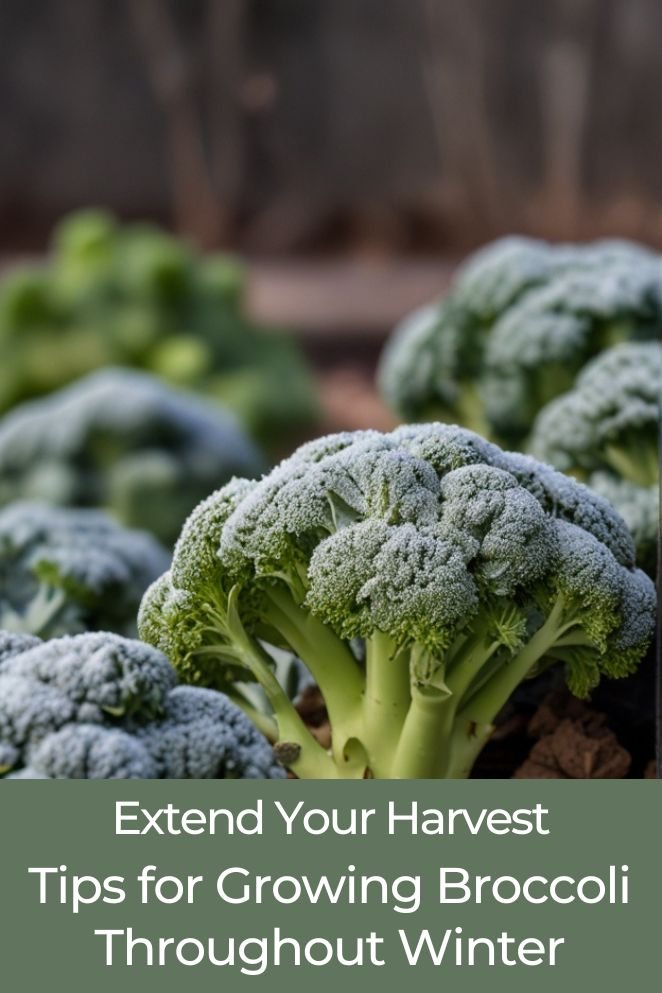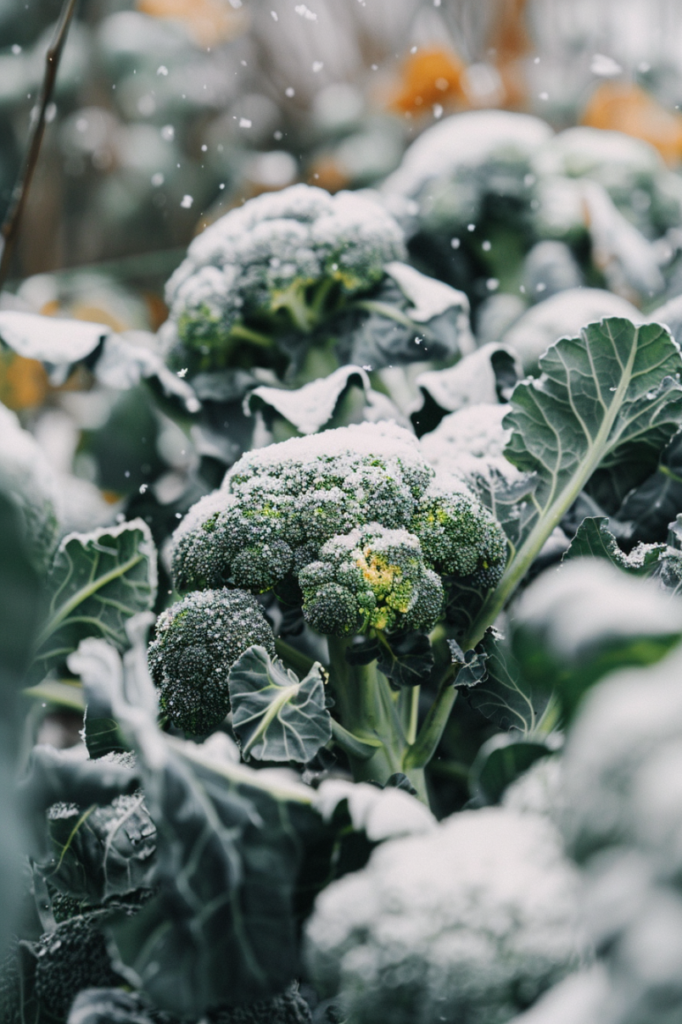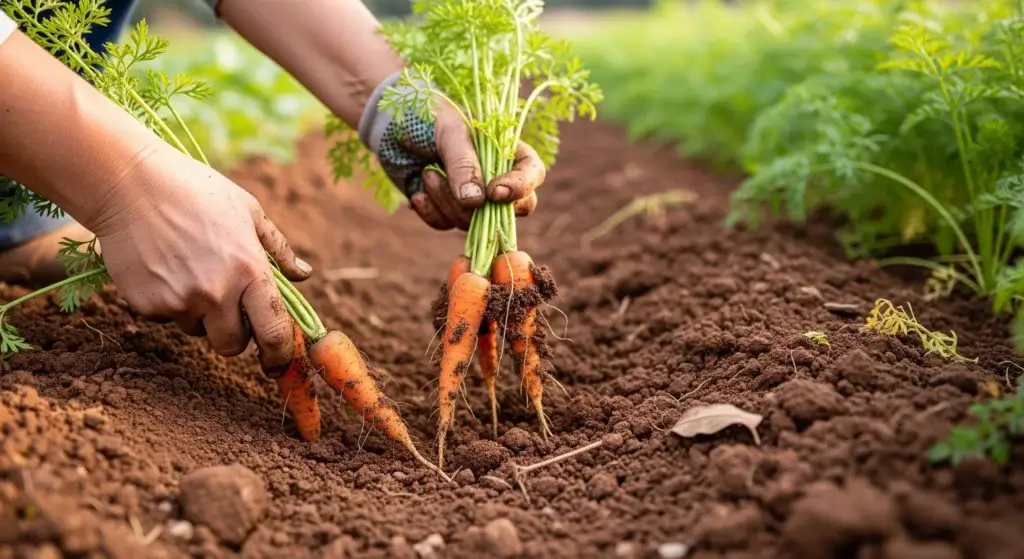
Growing broccoli in winter can be a challenging yet rewarding experience for gardeners.
With the right planning and care, you can enjoy fresh, homegrown broccoli throughout the colder months.
In this blog post, we’ll discuss the steps to successfully grow broccoli in winter, from choosing the right variety to caring for your plants.
Benefits And Challenges Growing Broccoli in Winter
| Benefits | Challenges |
| 1. Cooler temperatures enhance flavor and texture of broccoli. |
1. Cold temperatures may cause frost damage to broccoli plants.
|
| 2. Reduced pest pressure compared to warmer seasons. |
2. Risk of slower growth due to limited sunlight and shorter days.
|
| 3. Availability of space in the garden as other crops may not be growing. |
3. Increased susceptibility to diseases such as damping-off in wet and cold conditions.
|
| 4. Broccoli can withstand light frosts, extending the harvest season. |
4. Requirement for adequate protection from freezing temperatures to prevent damage to broccoli heads.
|
| 5. Harvesting broccoli during winter provides fresh produce when fewer vegetables are available. |
5. Potential challenges in maintaining soil moisture levels during cold weather.
|
Planning for Winter Broccoli
Planning for winter broccoli involves several key steps to ensure a successful harvest. Here’s how to get started:
Choosing the right variety:
Selecting the appropriate broccoli variety is crucial for winter planting.
Look for varieties with shorter maturity times and good cold tolerance.
Some recommended varieties for winter planting include ‘Waltham 29’, ‘Green Comet’, and ‘De Cicco’.
These varieties are known for their ability to withstand colder temperatures and produce well during the winter months.
Starting broccoli indoors:
Starting broccoli indoors is an excellent way to get a head start on your winter garden. Here’s how to do it:
Timing
Sow broccoli seeds indoors approximately 4-6 weeks before the expected last spring frost date in your area.
This timing allows the seedlings to grow and develop before transplanting them into the garden.
Container selection
Choose a container with good drainage to prevent waterlogging.
Fill the container with a high-quality seed-starting mix, which provides the ideal growing medium for young broccoli plants.
Planting seeds
Plant broccoli seeds about 1/4 inch deep in the seed-starting mix.
Gently water the seeds to ensure they are moist but not waterlogged.
Place the container in a warm, sunny location, such as a windowsill or under grow lights.
Care and maintenance
Keep an eye on the seedlings as they grow, ensuring they receive adequate sunlight and water.
Once the seedlings have developed several true leaves and are strong enough to handle transplanting, they can be moved into the garden.

Planting Broccoli Outdoors in Winter
When venturing into planting broccoli outdoors during the winter, meticulous preparation and care are key to ensuring a successful harvest.
Let’s delve into the steps involved:
Preparing the planting bed
Choosing the right location
Opt for a sunny spot with well-drained soil for your broccoli bed.
Broccoli thrives in full sunlight, so aim for a location that receives at least six hours of direct sunlight per day. Ensure the soil is well-drained to prevent waterlogging, which can lead to root rot.
Soil preparation
Before planting, it’s essential to assess the soil’s pH level.
Broccoli prefers slightly acidic soil with a pH range of 6.0 to 7.0. Test the soil pH and amend it if necessary by adding lime to raise the pH or sulfur to lower it.
Incorporate organic matter, such as compost or well-rotted manure, into the soil to improve its structure and fertility.
Planting broccoli seedlings
Space broccoli seedlings approximately 18-24 inches apart, with rows spaced 3-4 feet apart.
Dig holes slightly larger than the root balls of the seedlings and gently transplant them into the prepared bed.
Ensure the soil is firmly packed around the seedlings to provide stability and support as they grow.
Planting and caring for broccoli outdoors
Regular watering
Keep the soil consistently moist by watering your broccoli plants regularly.
During the winter months, rainfall may be insufficient, so monitor soil moisture levels closely and water as needed to prevent the soil from drying out.
Avoid overwatering, as waterlogged soil can lead to root rot and other issues.
Mulching
Apply a layer of mulch around the base of the broccoli plants to help retain warmth and moisture in the soil.
Mulching also helps suppress weeds, which can compete with broccoli for nutrients and water.
Use organic mulch such as straw, shredded leaves, or compost, and replenish it as needed throughout the growing season.
Pest and disease monitoring
Keep a close eye on your broccoli plants for signs of pests and diseases, such as aphids or clubroot.
Inspect the foliage regularly for any abnormalities, and take prompt action if you notice any issues.
Consider using organic pest control methods, such as hand-picking pests or applying insecticidal soap, to manage pest infestations without the use of harmful chemicals.

Common Winter Pests That Affect Broccoli Plants
During the winter months, broccoli plants can face a variety of pests that threaten their health and productivity.
Here’s a closer look at some common winter pests that affect broccoli plants and the damage they can cause:
Cabbage worms
Cabbage worms are the larval stage of moths and butterflies.
They feed voraciously on broccoli leaves, often leaving behind ragged holes and skeletonized foliage.
Severe infestations can significantly reduce plant vigor and yield.
Aphids
Aphids are small, soft-bodied insects that cluster on the undersides of broccoli leaves.
They pierce the plant tissue to feed on sap, causing leaves to curl, yellow, and distort.
Aphids also excrete honeydew, which can lead to the growth of sooty mold and further damage the plant.
Flea beetles
Flea beetles are tiny, black insects that hop when disturbed.
They feed on broccoli foliage, leaving behind numerous small holes that can coalesce and result in extensive damage.
Flea beetle feeding can weaken seedlings and reduce the yield of mature plants.
Cutworms
Cutworms are nocturnal pests that sever young broccoli seedlings at ground level, often causing them to wilt and die.
They can also bore into the heads of mature broccoli plants, leading to extensive damage and reduced harvest yields.
Diamondback moths
Diamondback moths lay their eggs on the undersides of broccoli leaves, and the resulting larvae feed on the foliage, causing extensive defoliation.
Severe infestations can stunt plant growth and reduce overall yield.
Cabbage root maggots
Cabbage root maggots attack the stems and roots of broccoli plants, causing wilting, yellowing, and eventual plant death.
These pests tunnel into the plant tissue, leading to secondary infections and reduced nutrient uptake.

Conclusion
Growing broccoli in winter can be a delicious and rewarding experience for gardeners.
By choosing the right variety, starting seeds indoors or purchasing seedlings, and providing proper care, you can enjoy fresh, homegrown broccoli throughout the colder months.



